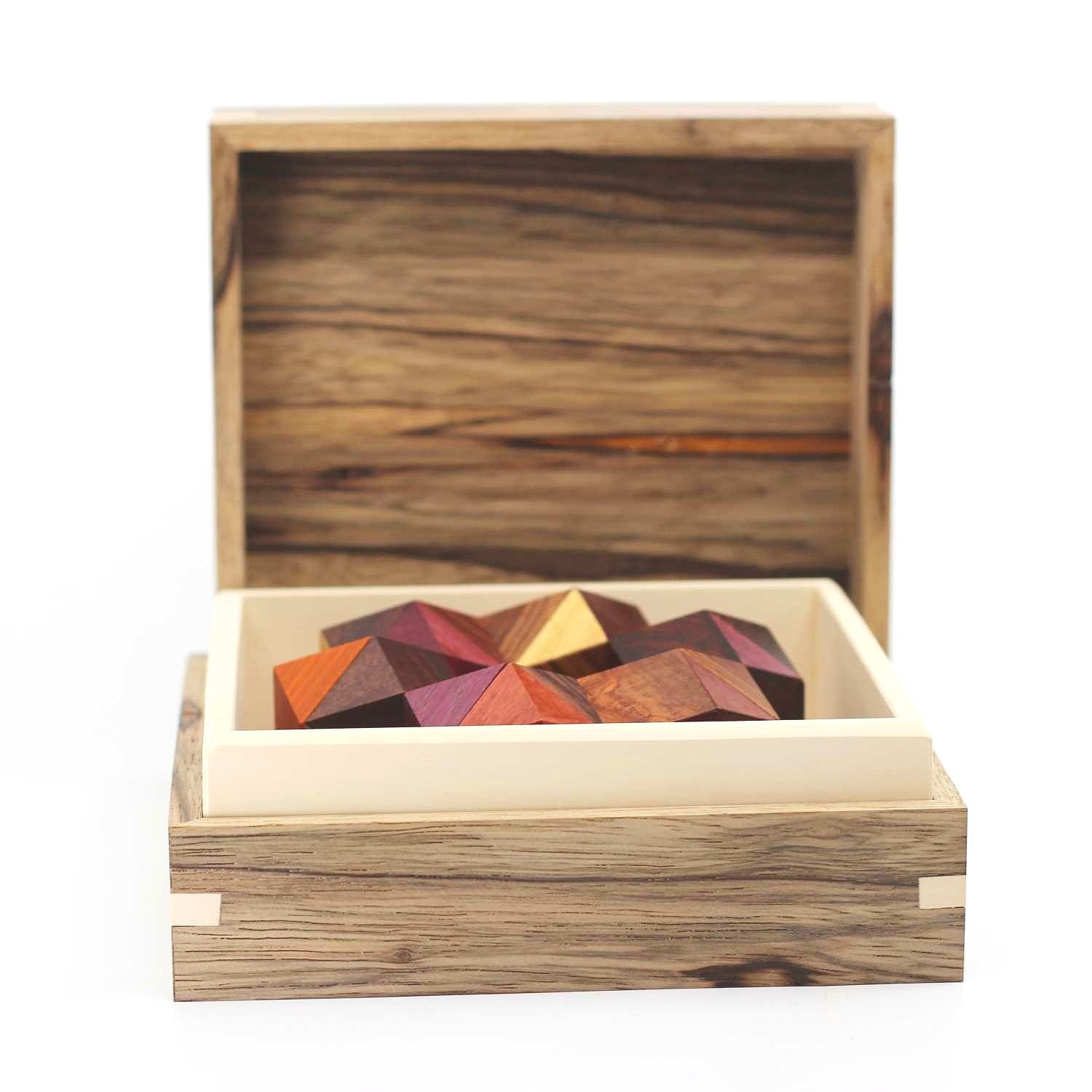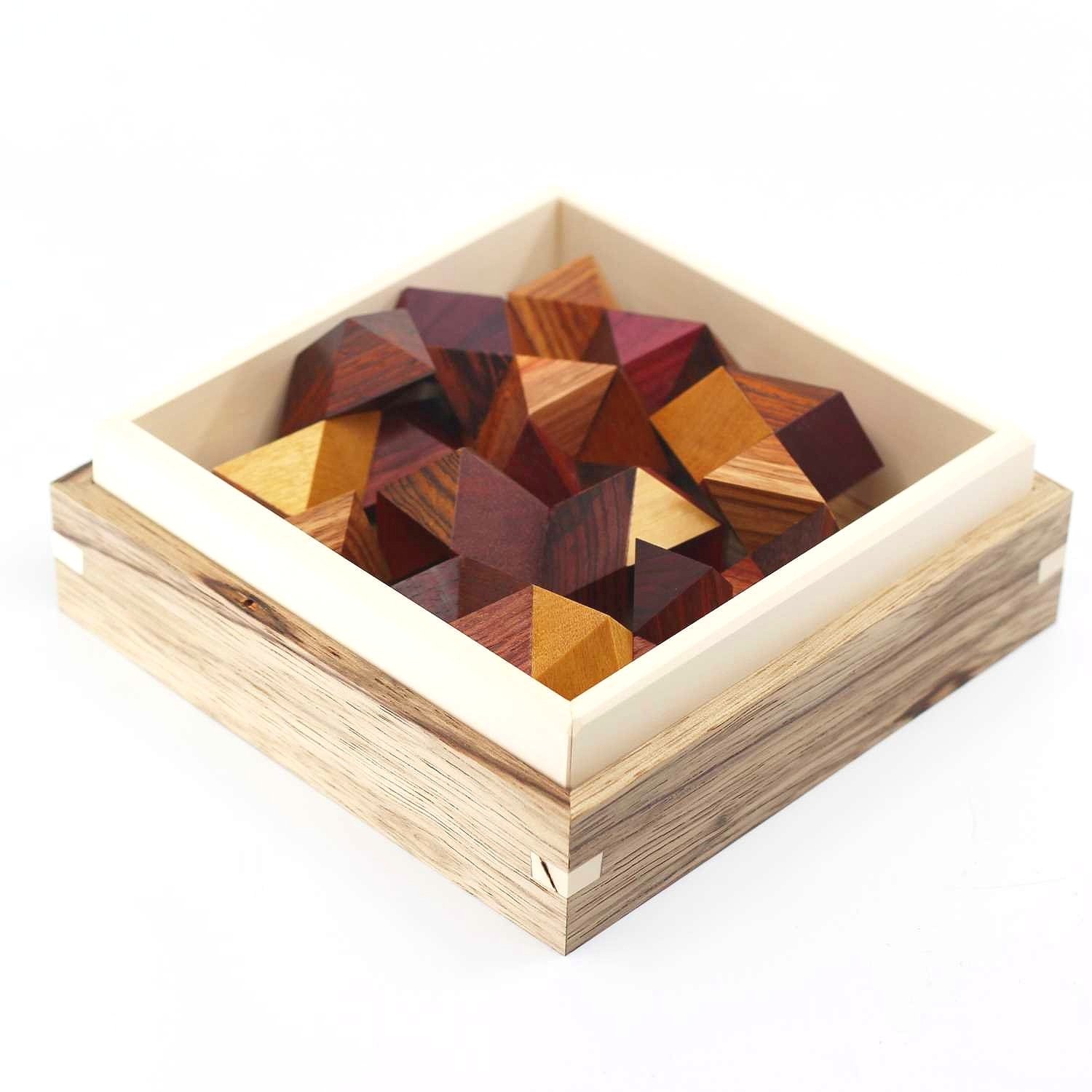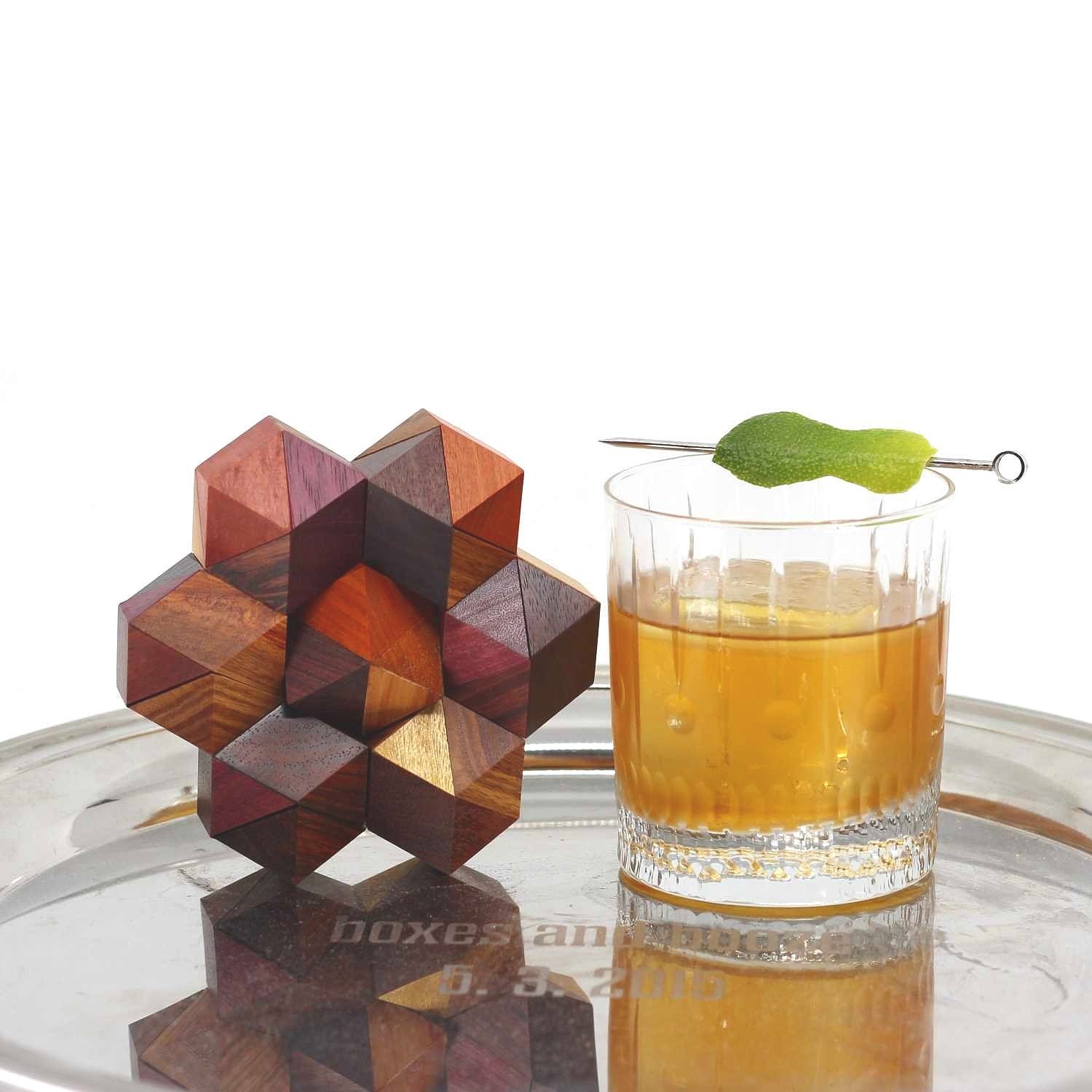Mass Appeal
Peanut Puzzle
Peanut Puzzle STC 67 by Mark Mccallum
I’ve mentioned before that I don’t like to “box myself in” here, and purposefully take a detour now and then. I’m originally from New England, and thought it might be nice to take a “trip” to the Northeast, to visit with one of the greats. This detour was inspired by someone closer to my home in Texas, wood worker Mark McCallum from Oklahoma. Mark recently created a limited set of an interlocking polyhedral puzzle which was discovered fifty years ago by one of the greatest geometric dissection artists in modern times, Stewart Coffin.
Much has been written about Stewart Coffin, by others and by Stewart himself, and I am in no position to add anything meaningful, but I will at least offer a brief introduction. Stewart Coffin began his professional career at the MIT Digital Computer Laboratory in 1953. After ten years he gave that up and began crafting wood kayaks, canoes, and paddles on his nine-acre farmstead in Massachusetts. He loves the outdoors, and to write, and spent time in pursuit of both passions. He also had a knack for making complex interlocking “polyhedral structures”, and devoted many long hours experimenting, tinkering and creating. He is extremely well known in the world of mechanical puzzles for his extensive Compendium of interlocking designs, which are all numbered in sequence. But he would prefer not to say that he invented these puzzling objects.
Display presentation box in Black Limba by John Devost
“I shy away from using the word “invent.” Instead, one finds “explore” and “discover” used more often. As for the word “puzzle,” which is so often associated with children’s toys, I actually set out to write my Compendium without once using that unfortunate word, but of course it proved to be hopelessly awkward, so we must live with it.” Stewart Coffin is a prolific writer, with six books, several dozen works of fiction and non-fiction, some verse, and even songs to his credit, and may best be thought of as an artist, a word which captures his life more completely. Of course, he is also extremely humble. “At the beginning of my woodworking craft in 1970, I adopted the slogan “AP-ART, the sculptural art that comes apart.” Over the years I have used a couple variations – the polyhedral art... or the geometric art..., but always including the word art. However I would decline to call myself an artist out of respect for all those who really were, such as the great Masters of the Renaissance.” – Stewart Coffin, Reflections, 2022
nutcase?
The “Peanut Puzzle” (STC#67) origins can be traced back to Stewart’s earliest books on polyhedral dissection art, and was “discovered” in 1973. He observed that “One of the charms of the simple two-dimensional dissection puzzles … is that they construct many different simple geometrical shapes with the same set of pieces.” Attempts to reconfigure sets of three-dimensional pieces led to the question, “Is it possible for a set of interlocking puzzle pieces to construct many different polyhedral shapes?” His line of inquiry led to twelve different shapes which were a result of dissecting a rhombic dodecahedron into identical halves, then reconfiguring those pieces in all the possible asymmetric ways. The twelve “peanuts” could potentially combine to make eight different interlocked symmetrical shapes (small triangle, square, tetrahedron, hexagonal ring, large triangle, octahedron, square pyramid, diamond) using six individual pieces or fewer. Coffin queried his readers, “Now for the interesting part. Can you find a subset of six pieces from the set of 12 that will construct all eight of the above figures?” Spoiler – you cannot. “Of the 924 possible such subsets, there is one, however, that will construct seven of the eight figures. Find it if you can, keeping in mind that the seeking may be more fun than the actual finding.” He did not reveal the ideal set of six pieces in his original books.
peanut brittle
His initial impression in 1973 was to produce the puzzle in plastic someday. In 1986 he revisited the design, and made about thirty “ideal” sets in mahogany, commenting that although it required a high degree of accuracy, it was not a difficult puzzle to make. Even Mark McCallum, an exceptionally good wood worker, suggests that this was a bit of an exaggeration. Mark explains the allure and complexities of this puzzle. “Peanut has always been one of my favorite Coffin designs because it makes so many different shapes. You pull apart the pieces, and almost immediately forget how they went together, and find yourself exploring all the different possibilities as you try and find some sort of solution. A majority of puzzles are single solution, and once you've solved it, the fun is over. This one is different. Stewart says in his Compendium that he made 30 of them, and I know other makers have made some too, but this puzzle should be much more available than it is. Several challenges have to be overcome to make a " nice" version of this puzzle. The most important and most difficult obstacle is the fit. It has to be just slightly loose to prevent binding between pieces. Pieces that bind usually end up getting broken, as the user has to exert more force to separate the pieces. The pieces go together in a lot of ways, so overall tolerances have to be held closely. Mixing different woods also adds to the complexity, as all woods machine a little differently. Putting six sticks through a thickness planer at the same setting does not necessarily mean you get six identical sticks in thickness. These sorts of variables have to be measured and accounted for to hold tight tolerances. In order to be able to mix lots of woods like I did for yours, processes have to be under control. I 3d printed a two piece pennyhedron and used it as a jig to glue every single Peanut piece, so each piece had the same accurate reference.”
Charles Schulz had nothing on this
Coffin discovered and catalogued hundreds of designs, and I was curious which one might be McCallum’s personal favorite. “Asking which Coffin puzzle is my favorite is like asking which child do you love most. I enjoy them all. Having said that, I love Jupiter for its geometry, Rosebud as one of the first coordinate motion puzzles, 12 pc Separation for its shifting of pieces back and forth, and of course Peanut for all the different shapes it makes.”
Many fine copies of the “peanut puzzle”, made by incredibly talented craftspeople, have been produced over the years. Mark McCallum’s may be one of the finest yet, produced in a stunning combination of exotic, rare, and now endangered wood species such as this version with Brazilian Tulipwood, Kingwood, Cocobolo, East Indian Rosewood, Yucatan Rosewood, Chakte Viga, Canarywood, Bocote, Bubinga, Purpleheart, and Yellowheart. Each of the twenty-five puzzle sets Mark created are unique. They provide a beautiful home for some of the incredible wood inventory he has amassed over the decades, which includes species no longer available due to international conservation bans. These treasures have new life now, in one of the most enjoyable ways. Expanding upon Coffin’s original seven shapes, and including other shapes that both Coffin and McCallum discovered, the new set presents thirty possible challenges which can be constructed from the pieces.
While exploring these challenges, I pondered some final words of Stewart Coffin’s storied wisdom, which he recently shared with me. “One point I have already made, and which I will now repeat, is that designing puzzles like Peanut did not require much brains or creative talent. Like many of the others, it was mostly many long hours of working patiently, trial and error, until something turns up. Most of the incentive came from it being my business and main source of income for many years. Recently, at age 92, I decided to retire from woodworking, and I have given away all of my hobby woods and some of my tools. Now happily enjoying retirement.”
“I guess we all need to try being optimistic and keep striving to make things better. After all, there is really no other choice. At least that is the way I see things.”
- Stewart Coffin, Reflections, 2022
Mass Appeal by Chelsea Gregoire
I’m toasting the peanut, a good old fashioned puzzle which is perpetually being remade, with a good old fashioned cocktail of similar circumstance. This particular Old Fashioned comes from Church, a “place to watch” in Baltimore, Maryland, that promises to redefine what a community gathering place can be. Proprietor, owner and consultant Chelsea Gregoire, who was Esquire’s Beverage Director of the Year in 2019, created the drink and gave it the clever name as a nod to the bar’s own. The label stuck, and the drink is indeed a local favorite. I’m sharing it now as another nod to an incredibly popular artist with a massive catalogue who also happens to hail from Massachusetts. I lost count of how many entendres that makes it.
religious experience
The cocktail features rye, which has recently become my favorite whiskey. The apple tincture provides a sustainable use for leftover apple pulp which is derived initially from making a separate apple syrup. The remaining pulp is infused into neutral grain spirit or vodka to make a tincture. This is great if you happen to need an apple syrup, but I had no particular use for that, and already had a bottle of baked-apple cocktail bitters, which I used here to great effect. The grains of paradise syrup is also an unusual ingredient, but I was feeling adventurous so purchased some inexpensive bulk grains of paradise spice, pulverized it, and made the syrup. The process was also an educational one, as the spice was new to me. With origins in West Africa, this peppercorn like spice is described as having “notes of cardamom, coriander, citrus, ginger, nutmeg, and juniper”. I found it to be quite floral as well. Next time you are in Baltimore, you might consider going to Church, and letting this spirit move you. Cheers!
go nuts for this pair
Mass Appeal by Chelsea Gregoire
2 ½ oz rye whiskey
½ oz grains of paradise syrup
4 dashes apple tincture
2 dashes orange bitters
Combine ingredients in a glass with a large cube and stir.
I highly encourage you to read more about Stewart Coffin’s many interests on his new website.











